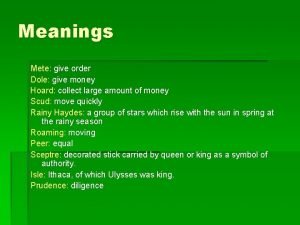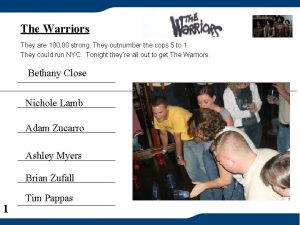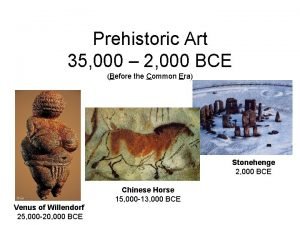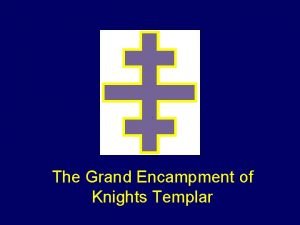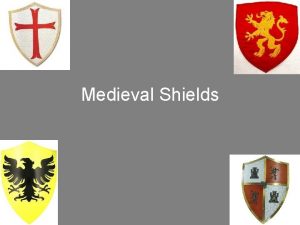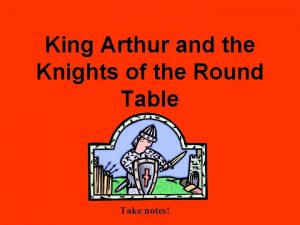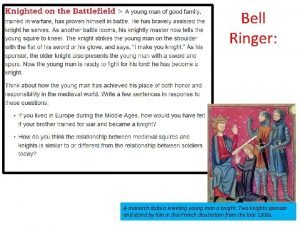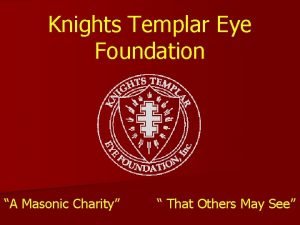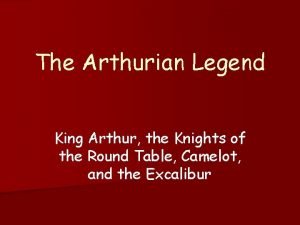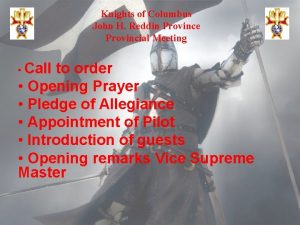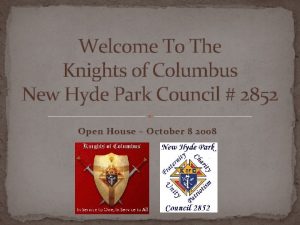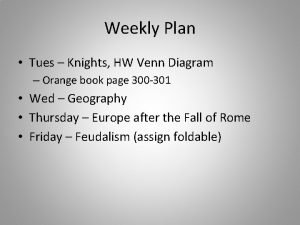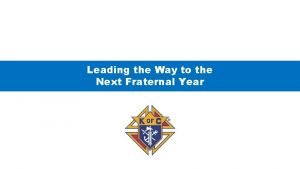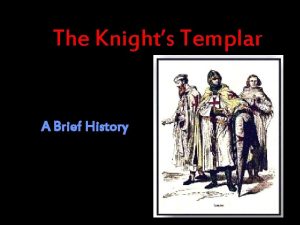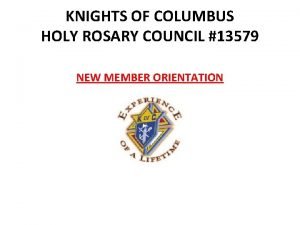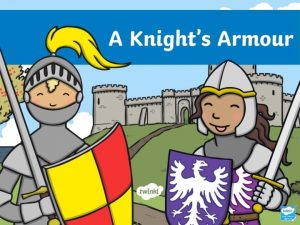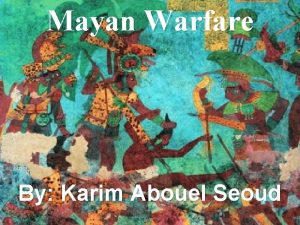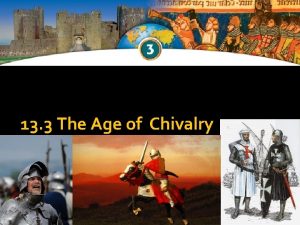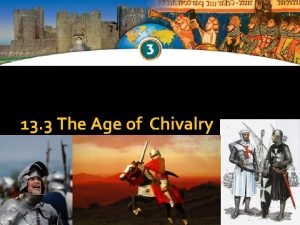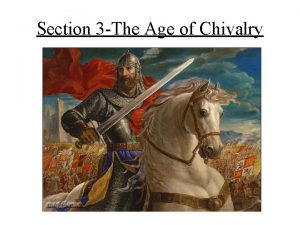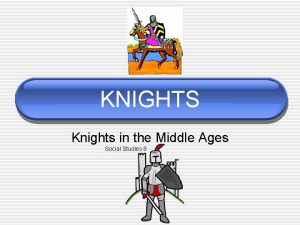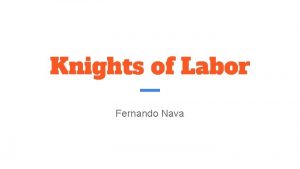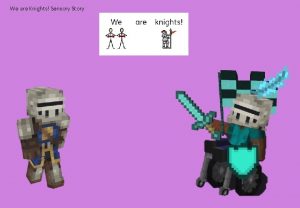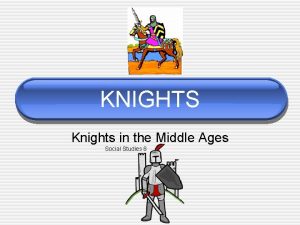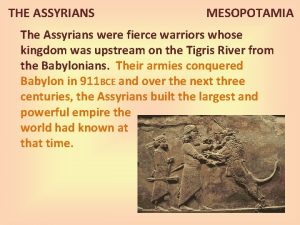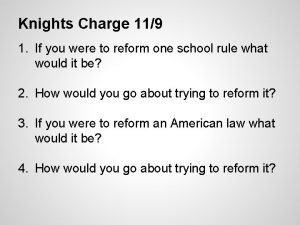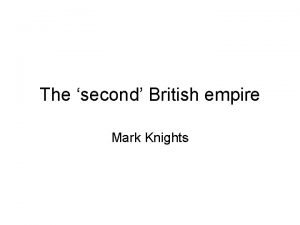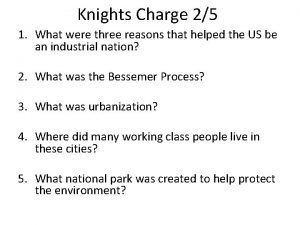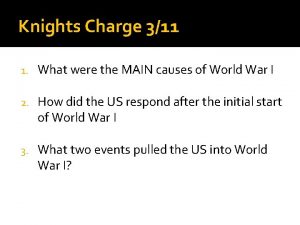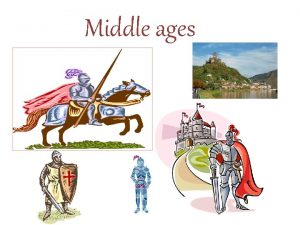Knights Who were Knights Knights were warriors who





















































- Slides: 53

Knights

Who were Knights? Knights were warriors who rode on horseback and fought with swords and spears. They were always men. Knights lived in the Middle Ages between 1000 - 1500 AD. Most knights came from noble families. Some were rich and powerful, and some lived in lovely castles, but, most were poor.

Who were Knights? Knights were also kings and princes. At the end of the Middle Ages, some knights became professional soldiers, fighting for anyone who would pay them.

Who were Knights? It was a knight's duty to fight bravely whenever the king or lord needed his help. Knights did have other duties, too. They were expected to be courteous to their enemies, treating prisoners humanely, and not attacking civilians. Knights were expected to behave in a certain way. The ideal knight would be humble, loyal, fair, Christian and have good manners.

Who were Knights? Knights were meant to be chivalrous. Here are some of the codes which Knights tried to live by: • To follow the church and defend it with his • • • life To protect women and the weak To serve and defend the king To be generous and honest To never lie To live by honour and for glory To help widows and orphans

Armour During the Middle Ages, knights wore heavy armour made of metal. There were two main kinds of armour: 1. Chain mail 2. Plate armour

Armour Chain mail was made from thousands of metal rings. The typical chain mail armour was a long cloak called a hauberk. Knights wore a padded cloak underneath the armour to help them carry the weight of the armour. Although chain mail was flexible and offered good protection, it could be pierced by an arrow or thin sword.

Armour Knights wore armour made of metal, padded cloth and leather. They covered their head with metal helmets. By 1400, armour was made of steel plates riveted together. It was hot, and heavy, but very strong.

Armour

Armour Putting on a suit of armour

Weapons Knights of the Middle Ages used a variety of weapons. Some weapons were more effective when charging on a horse (like the lance), while others were better for hand to hand combat (like the sword).

Weapons The lance was a long wooden pole with a metal tip and hand guards. Because the lance was so long, the knight could attack from his horse. This gave the knight a serious advantage against foot soldiers. The lance could also be used to knock enemy knights off of their horses.

Weapons The sword was the preferred weapon once the knight had dismounted or if his lance was broken during battle. Some knights preferred a one-handed sword and a shield, while others preferred a larger two-handed sword.

Weapons The mace was a club with a big steel head. These weapons were designed to crush an enemy.

Weapons Many knights considered the longbow to be a cowardly weapon. However, the longbow became a major part of winning battles in the Middle Ages. The longbow could attack from a distance or a castle wall.

Craftsmen Knights relied on craftsman who were very skilled at their trade: • Blacksmiths made harness fittings and iron shoes for warhorses.

Craftsmen Knights relied on craftsman who were very skilled at their trade: • Swordsmiths and cutlers made swords and sharp blades.

Craftsmen Knights relied on craftsman who were very skilled at their trade: • Armourers made all kinds of metal weapons and armour, plus helmets and metal hats, called sallets, for soldiers.

Battle equipment Knights setting off to fight an enemy had to take lots of stuff. They took weapons, armour, tents, bedding, medicines, spare horses, axes to cut wood for campfires, clean clothes, and food for the long journey.

Battles Knights fought on horseback and on foot. On horseback, they would ride side by side, charging toward the enemy. They hoped to spear them with their long, sharp lances or knock them to the ground. Knights had to fight on foot when their wasn't any room to ride side by side.

Battles One of the knight's most important possessions was his war horse. This horse was trained for battle. A good war horse could mean the difference between life and death for a knight. The knight's war horse was called a Destrier. The horse also wore armour for protection including metal plates to cover its neck, head, and sides.

Coat of Arms Knights and nobles in the Middle Ages often had a coat of arms. This was a special symbol that represented their family. Having a special symbol or coat of arms is often called "heraldry".

Coat of Arms The first coat of arms was used to distinguish one knight from another. When a knight had on his full armour, including plate mail and helmet, even his friends couldn't recognise him. Because of this, knights began to paint symbols on their shields. They eventually began to put the symbol on their banner and the coat they wore over their armour. This is how it got the name "coat of arms".

Coat of Arms Each coat of arms needed to be unique. However, there were so many knights that it was tough to keep track of who had what symbol. It became the job of people called heralds to keep track of the different coats of arms. They made sure that new coats of arms were unique. They also kept track of who each coat of arms belonged to.

Coat of Arms Over time, there became strict laws in applying for a new coat of arms. Each new coat of arms needed to be registered with the government. A coat of arms belonged to the family of the knight. He would pass the coat of arms down to his eldest son.

Coat of Arms The original coats of arms had fairly simple designs. As there became more and more coats of arms, the designs became more complicated in order for each one to be unique. All coats of arms have certain elements, however.

Coat of Arms The escutcheon is the main shape of the coat of arms. It was in the shape of a shield, but the exact shape could vary.

Coat of Arms • The field was the background colour. At first the field was a solid colour, but later patterns began to be used for the field. • The charge is the main picture in the centre of the coat of arms. It was usually an animal, but could be other things such as a sword or a ship. • Ordinaries were designs that appeared on the field. They added additional colour and uniqueness to the coat of arms.

Coat of Arms

Coat of Arms Different background colours came to have different meanings. Red was the colour of a warrior and nobility. Other colours included blue for truth and sincerity, black for piety and knowledge, and green for hope and joy. English heraldry has 7 colours: silver, gold, red, blue, purple, black and green.

Coat of Arms The charges used as the main figure in the coat of arms had different meanings as well. The lion stood for majesty and strength

Coat of Arms The charges used as the main figure in the coat of arms had different meanings as well. The elephant for wit and ambition

Coat of Arms The charges used as the main figure in the coat of arms had different meanings as well. The boar for courage and ferocity

Coat of Arms The charges used as the main figure in the coat of arms had different meanings as well. The sun for power and glory

Design your own Coat of Arms 1. 2. 3. Choose the shape of your shield Choose your colour scheme Choose your main image (animal or shape) 4. Create your design including any patterns and other images 5. You could include elements of the human values

Famous Knights 1. 2. 3. 4. 5. 6. 7. 8. 9. 10. King Arthur Richard the Lionheart El Cid Alexander Nevsky Edward the Black Prince William Wallace Henry ‘Hotspur’ Percy Bertrand du Guesclin John Hawkwood Joan of Arc

Famous Knights King Arthur is thought to be an actual historical figure. His life, however, is surrounded by many myths and legends. He appears in historical sources as a British soldier, but there is no evidence for his knights of the round table, his miraculous sword Excalibur or other fantastic elements from the Arthurian legend.

Famous Knights Richard the Lionheart also known as Richard I of England (1157 -1199) succeeded his father Henry II as King of England in 1189 but he spent most of his reign abroad. He went on to lead the Third Crusade (1189 -1192) where he confirmed his reputation of a great military leader.

Famous Knights El Cid (1043 -1099) was a Castilian knight whose real name was Rodrigo Diaz de Vivar. He was called El Cid by the Moors whom he fought against most of his life. The Spanish national hero didn’t always fight against the Muslim rulers of medieval Spain; occasionally, he fought for them as well.

Famous Knights Alexander Nevsky (c. 12201263), Prince of Novgorod and Grand Prince of Vladimir is the most celebrated medieval Russian military leader. He assumed the name Nevsky after he defeated the Swedes on the Neva River in 1240 and repulsed the threat of an invasion of Russia.

Famous Knights Edward the Black Prince Edward of Woodstock, Prince of Wales (13301376) came to be called the Black Prince (most likely after the black armour he wore) after the Battle of Crecy (1346), one of the most notable battles of the Hundred Years’ War.

Famous Knights William Wallace (c. 12721305) was one of the most important figures in the Wars of Scottish Independence (1296 -1328). In 1297, he killed the English Sheriff of Lanark and soon established himself as one of the leaders of the Scottish rebellion against the English.

Famous Knights Henry ‘Hotspur’ Percy Sir Henry Percy (13641403), nicknamed Hotspur for his temper was knighted as a 13 -year-old boy. He was sent to France where his reputation grew, but after his family came into conflict with the new King Henry IV, Henry rebelled against the King of England took up arms.

Famous Knights Bertrand du Guesclin (c. 1320 -1380) is regarded as the greatest French knight of his time. His successful defense of Rennes (1364) against the English significantly raised the French morale but it also attracted the King’s attention.

Famous Knights John Hawkwood was one of the most famous and successful warriors of his time. He rose to prominence during his service to the English in the Hundred Years’ War (1337 -1453) and is said to be knighted but it isn’t known when and by whom.

Famous Knights Joan of Arc 1412– 1431), nicknamed "The Maid of Orléans" is a folk heroine of France and a Roman Catholic saint. Joan said she had received visions from God instructing her to support Charles VII and recover France from English domination late in the Hundred Years' War. She gained prominence after the siege was lifted in only nine days. and was burned at the stake for heresy when she was about 19 years old.

Saint George

Saint George St. George is the patron saint of England. His emblem, a red cross on a white background, is the flag of England, and part of the British flag. St George's emblem was adopted by Richard The Lion Heart and brought to England in the 12 th century. The king's soldiers wore it on their tunics to avoid confusion in battle.

Saint George St George was a brave Roman soldier who protested against the Romans' torture of Christians and died for his beliefs. The popularity of St George in England stems from the time of the early Crusades when it is said that the Normans saw him in a vision and were victorious.

Saint George is popularly identified with England English ideals of honour, bravery and gallantry, but actually he wasn’t English at all. Very little is known about the man who became St George. • • Born in Turkey (in Cappadocia) Lived in 3 rd century His parents were Christian Became a Roman soldier Protested against Rome's persecution of Christians Imprisoned and tortured, but stayed true to his faith Beheaded at Lydda in Palestine

Saint George One of the best-known stories about Saint George is his fight with a dragon, but it is highly unlikely that he ever fought a dragon, and even more unlikely that he ever actually visited England. Despite this, St George is known throughout the world as the dragonslaying patron saint of England.

Saint George The most famous legend of Saint George is of him slaying a dragon. In the Middle Ages the dragon was commonly used to represent the Devil. The slaying of the dragon by St George was first credited to him in the twelfth century, long after his death. It is therefore likely that the many stories connected with St George's name are fictitious. There are many versions of story of St George slaying the dragon, but most agree on the following: • A town was terrorised by a dragon. • A young princess was offered to the dragon • When George heard about this he rode into the village • George slayed the dragon and rescued the princess

Saint George How does England celebrate St George’s Day? By tradition, 23 April is the day for a red rose in the button hole, the national flower. On the Sunday nearest to 23 April, scouts and guides throughout England parade through high streets and attend a special St George's Day service at their local church.
 Yesus sebagai pejuang kerajaan allah
Yesus sebagai pejuang kerajaan allah Kansa powershell
Kansa powershell Warriors fire and ice summary
Warriors fire and ice summary Ogden utah gangs
Ogden utah gangs Mete and dole meaning
Mete and dole meaning Warriors don't cry chapter 6
Warriors don't cry chapter 6 The boyle avenue runners
The boyle avenue runners Fccs warriors
Fccs warriors Crsc lawyers
Crsc lawyers Mammoth ivory carving
Mammoth ivory carving Knights templar membership
Knights templar membership Knight templar eye foundation
Knight templar eye foundation Delta church drive
Delta church drive Joe louis membership
Joe louis membership Dan brown knights templar
Dan brown knights templar Northern knights football
Northern knights football Knights of columbus treasurer handbook
Knights of columbus treasurer handbook Knights capital group
Knights capital group Condor v barron knights
Condor v barron knights Knights templar grand encampment
Knights templar grand encampment Medieval shields designs
Medieval shields designs 164chairman
164chairman Knights of the round table names
Knights of the round table names Knights of pythias greenwood cemetery
Knights of pythias greenwood cemetery Knights of labor apush
Knights of labor apush Knights and knaves discrete math
Knights and knaves discrete math The ideal knight respected and vigorously defended his
The ideal knight respected and vigorously defended his Knights capital group
Knights capital group Monarch knights
Monarch knights Sue knights
Sue knights Knights of columbus brampton
Knights of columbus brampton Women's trade union league apush
Women's trade union league apush Knights templar eye foundation
Knights templar eye foundation Knights of the round table names
Knights of the round table names Knights of columbus form 186
Knights of columbus form 186 Knights of columbus new hyde park
Knights of columbus new hyde park Knight and samurai venn diagram
Knight and samurai venn diagram Higley knights
Higley knights Knights of columbus
Knights of columbus Creekside knights football
Creekside knights football Le chevalier de baphomet
Le chevalier de baphomet Knights of columbus
Knights of columbus River ridge knights football
River ridge knights football Special suit
Special suit Geoff dennis
Geoff dennis Knights of the altar ranks
Knights of the altar ranks Mrs fountain
Mrs fountain Kavita deepak knights
Kavita deepak knights Future in past
Future in past Alleghanian orogeny
Alleghanian orogeny Where were the celts from
Where were the celts from Tore the veil meaning
Tore the veil meaning Grecian jews
Grecian jews Active voice
Active voice




